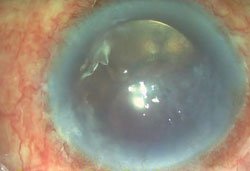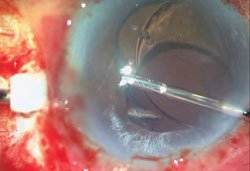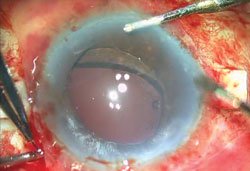Combination technique offers ability to fixate IOL, perform endothelial keratoplasty
 Amar Agarwal |
Descemet’s membrane is a vital layer of the cornea, and any damage to the endothelial cells can lead to endothelial decompensation. This can occur primarily as part of Fuchs’ dystrophy or secondary to surgical trauma. The most common cause of surgical trauma is cataract surgery and consequent aphakic or pseudophakic bullous keratopathy.
Although many patients with pseudophakic bullous keratopathy have the IOL well-placed in the bag or sulcus, one can also come across a number of patients who have had complicated eye surgery that results in insufficient capsular support and inability to place an in-the-bag or sulcus-supported IOL. These patients are most commonly implanted with an anterior chamber IOL or a sutured scleral-fixated IOL, or they are left aphakic. A rarer presentation is one in which a posterior chamber IOL has been placed in the anterior chamber either accidentally or intentionally, resulting in consequent corneal decompensation.
Patients with an anterior chamber IOL or a posterior chamber IOL misplaced in the anterior chamber or aphakic patients with bullous keratopathy need secondary IOL implantation combined with corneal transplantation in the form of penetrating or lamellar keratoplasty. Descemet’s membrane endothelial keratoplasty was first described by Gerrit Melles, and we first described glued IOLs in 2007. We would now like to describe a new combined procedure wherein lamellar keratoplasty in the form of DMEK is combined with secondary IOL implantation using the glued IOL technique.
Graft preparation
The basic technique consists of preparing the donor graft by partially trephining it and then using a Sinskey hook to lift up the edge of the cut Descemet’s membrane. Once an adequate edge is lifted, non-toothed forceps are used to gently grab Descemet’s membrane at its very edge, and the graft is separated from the underlying stroma in a capsulorrhexis-like circumferential manner. It is then stained with trypan blue and replaced in the sterile corneal storage medium while the recipient eye is prepared.
DMEK with glued IOL
An anterior chamber maintainer is inserted, and two points are marked on the sclera exactly 180° apart. Two 2.5 mm x 2.5 mm lamellar scleral flaps are created on either side, centered on the marks. Trypan blue is used to stain the patient’s Descemet’s membrane before scoring and stripping it, approximately 8.5 mm in diameter (as marked from above the corneal surface) using a reverse Sinskey hook. A 20-gauge needle is used to create a sclerotomy about 1 mm to 1.5 mm from the limbus under each scleral flap, and a 23-gauge vitrector introduced through the sclerotomy is used to perform anterior vitrectomy.
In case of a posterior chamber IOL in the anterior chamber (Figure 1), the IOL is repositioned in a closed globe manner by exteriorizing its haptics through the sclerotomies (Figures 2a and 2b). In case of an anterior chamber IOL, the IOL is explanted and a new IOL is implanted by performing the conventional glued IOL technique. In aphakic eyes, a foldable IOL is injected into the anterior chamber and its haptics are exteriorized through the sclerotomy. In all situations, once both haptics are exteriorized, the Scharioth tuck is employed to tuck them into scleral tunnels made at the edge of the scleral flaps using a 26 gauge needle. Intracameral pilocarpine is used to constrict the pupil and, if necessary, a pupilloplasty is performed.
 Figure 1. Preop pseudophakic bullous keratopathy. Note: Posterior chamber IOL implanted in the anterior chamber. |
 Figure 2a. Posterior chamber IOL implanted in anterior chamber leading to corneal decompensation. The same posterior chamber IOL is being relocated into the posterior chamber using a closed globe glued IOL technique. The haptic is grabbed from over the iris using end-gripping MST forceps and, using a handshake technique, is transferred between the two hands until the tip of the haptic is held. |
 Figure 2b. The haptic is exteriorized through the sclerotomy made under the scleral flap. The same procedure is followed for the second haptic, which is exteriorized through a sclerotomy under a second scleral flap created 180° away from the first. Each haptic is then tucked into a scleral tunnel created at the edge of the scleral flap. |
 Figure 3. The DMEK graft is unrolled, and an air bubble is used to appose it against the overlying stroma. Images: Agarwal A |
The graft is carefully loaded into a STAAR ICL injector with the cartridge tip held occluded with a finger. It is then injected gently into the anterior chamber by plunging the soft-tipped injector, taking care not to fold the graft. Wound-assisted implantation is avoided, and the anterior chamber maintainer flow is titrated carefully to prevent backflow and extrusion of the graft through the incision. The graft orientation is checked, and the graft is unfolded gently using a small air bubble, as described by Melles. Once unfolded, an adequately tight air bubble is injected under the graft to float it up against the stroma (Figure 3). Interface fluid is milked out through pre-placed sutures. Tisseel fibrin glue (Baxter) is used to seal the lamellar scleral flaps, conjunctiva and clear corneal incisions.
This technique combines the advantages of stable fixation of the IOL as well as the advantages of lamellar keratoplasty. In contrast, an anterior chamber IOL has the disadvantage of decreased IOL-endothelial distance, which can cause long-term graft failure when combined with penetrating keratoplasty. It becomes especially disadvantageous when combined with Descemet’s stripping endothelial keratoplasty, in which the endothelium with donor stroma also occupies space within the anterior chamber, thereby bringing the anterior surface of the anterior chamber IOL very close to the DSEK lenticule. Hence, these patients need explantation of the anterior chamber IOL with secondary IOL fixation and corneal transplantation.
Sutured scleral-fixated IOLs can be combined with endothelial keratoplasty, but they have the disadvantage of a longer open-sky period, making the eye more vulnerable to potential complications such as expulsive hemorrhage. There is also more pseudophakodonesis associated with sutured IOLs because the fixation to the sclera is via sutures at two points, whereas in the glued IOL technique, the haptic of the IOL is anchored to the sclera along a significant portion of its length. This stability of the glued IOL can, in our opinion, lead to a decreased rate of graft dislocation as compared with a sutured scleral-fixated IOL, which has more intraocular mobility. The glued IOL also offers the ability to adjust the centration of the IOL at any time during surgery by simply adjusting the degree of tuck of the haptics into the scleral tunnel, unlike the longer and more tedious procedure that would be required to re-center a decentered sutured scleral-fixated IOL. All suture-related complications such as erosion, degradation and exposure are also eliminated. The fibrin glue seals the flaps hermetically over the haptics and makes the procedure safe. Another problem in endothelial keratoplasty in aphakic eyes with deficient capsules is the chance of the graft falling into the vitreous. This is avoided with the combination of DMEK and the glued IOL technique.
Conclusion
In our opinion, the glued IOL combined with DMEK offers the ability to secondarily fixate the IOL as well as perform endothelial keratoplasty in a safe and effective manner. Greater evolution in the preferred technique of endothelial keratoplasty, on which extensive research is under way in major international centers, is looked forward to in order to further increase the long-term success rate of the corneal graft.

- Amar Agarwal, MS, FRCS, FRCOphth, is director of Dr. Agarwal’s Eye Hospital and Eye Research Centre. Prof. Agarwal is the author of several books published by SLACK Incorporated, publisher of Ocular Surgery News, including Phaco Nightmares: Conquering Cataract Catastrophes, Bimanual Phaco: Mastering the Phakonit/MICS Technique, Dry Eye: A Practical Guide to Ocular Surface Disorders and Stem Cell Surgery and Presbyopia: A Surgical Textbook. He can be reached at 19 Cathedral Road, Chennai 600 086, India; fax: 91-44-28115871; email: dragarwal@vsnl.com; website: www.dragarwal.com.
- Disclosure: Dr. Agarwal is a consultant for STAAR Surgical.









